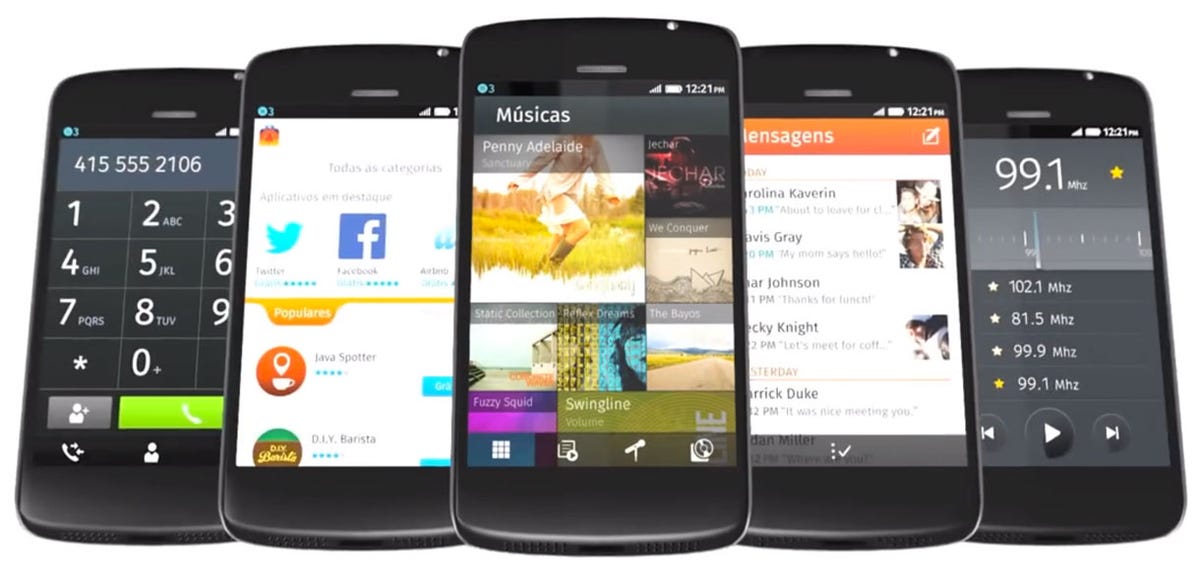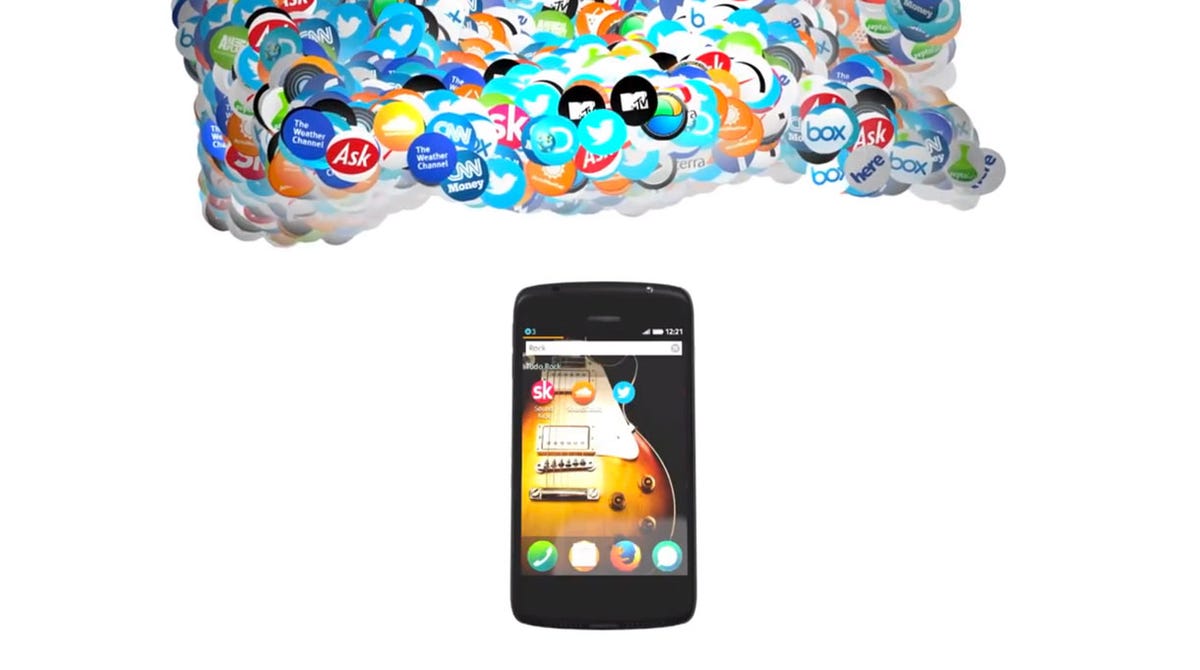
Telefonica Brazil screenshot by Stephen Shankland/CNET
In an impressive first-year achievement, Firefox OS has found a toehold in a fiercely competitive smartphone market. The next challenge for Mozilla’s browser-based mobile operating system will be to convert that toehold into a foothold.
As the struggles of BlackBerry OS, Microsoft Windows Phone, and Samsung Tizen have shown, it’s extraordinarily hard to find any room in a mobile operating system market where Apple’s iOS and Google’s Android dominate. Yet Mozilla has managed to do just that by focusing on super-low-cost smartphones and on partnerships with carriers who want something to offer in markets where even a bottom-of-the-barrel Android phone looks pricey.
“They’ve shown their strategy of going after the low end has been the right one,” said Ovum analyst Nick Dillon. “The emerging markets, bringing the Web and data to first-time smartphone buyers and feature-phone buyers for the first time — that’s where their strength lies. If they tried going up against mature smartphone platforms at a higher price point, they just would have got squashed.”
At last year’s Mobile World Congress show in Barcelona, Mozilla lined up a sizable collection of Firefox OS endorsements from carriers and phone makers. Only a few of them have anything for sale so far, though, so at the show this year Mozilla will have to show progress with new handsets and new markets.
Related stories
- iPad Pro 2020 reviews, YouTube to throttle video quality
- Mozilla helps modernize feature phones powered by Firefox tech
- Mozilla may start offering premium services this fall
- Sticker shock over Apple’s $1,000 stand, Firefox blocking cookies
- Mozilla three years later: Is Firefox in a better place?
That growth is an essential foundation for Mozilla’s Firefox OS goal: lower the barriers that confine people to one ecosystem or another — Apple’s combination of iPhone, iOS, App Store, and iTunes, for example, or Google’s combination of Android, Google Play, and online services.
Firefox OS is mostly brand-new to the mobile market. Analyst firms such as Gartner still lack estimates of phone shipments, so it’s hard to say with any certainty how well it’s done. But Mozilla’s top partner, the carrier Telefonica, is happy: last year, Firefox OS accounted for 12 percent of smartphone sales in Venezuela and more than 8 percent in Colombia. As Apple’s enviable profits show, developed economies are a terrific place to do business, but emerging markets are big, fast-growing, and more open to new smartphones brands.
The Web is key to Mozilla’s strategy. Firefox OS phones run Web apps written with Web technologies. And though Mozilla offers a Firefox Marketplace, apps can be discovered on the broader Web itself, too. In Mozilla’s aspirations, a person who pays for a Web-based app should be able to use it on any Web-enabled device and not have to pay for it again just because the other device is running a different operating system.
The wisdom of the browser-based approach is evident in how well it’s worked on PCs, where people access free and for-fee online services like Google Apps or Facebook without worrying overmuch about whether they’re using Safari on a Mac or Chrome on a Windows machine. But the strategy is hard on mobile devices. Smartphones are saddled with sluggish browser performance, missing or immature Web standards, and strong competition with rich, well-developed native programming foundations. Those challenges are amplified at the low end of the market, where performance is tough.


Telefonica Brazil screenshot by Stephen Shankland/CNET
But Mozilla Chief Technology Officer Brendan Eich sees an opening for Firefox OS. Although the new KitKat version of Android halves its memory requirement to 512MB, Firefox OS is taking the same memory-compression approach to halve its minimum to 128MB, he said.
“The only competition is running Gingerbread,” Eich said, referring to Google’s increasingly elderly version 2.3 of Android, which doesn’t require as much phone horsepower as the more recent Jelly Bean and KitKat releases. And Mozilla has heard Google’s Gingerbread support for its apps and Google Play Services software foundation “is going away” for all versions before Jelly Bean, he added, which would actually give Firefox even more breathing room.
Where things stand for Firefox OS Today, Firefox OS is chiefly available on the ZTE Open, LG Electronics Fireweb and Alcatel One Touch Fire phones, which went on sale in July 2013. The first carriers to sell Firefox OS phones were Telefonica in Spain, Venezuela, Colombia, and Brazil; Deutsche Telekom in Poland, Greece, and Hungary; Telecom Italia in Italy, and Telenor in Serbia, Montenegro, and Hungary.
At Mobile World Congress, we’ll certainly see new phones — but it’s not yet clear which ones beyond the new dual-core ZTE Open C. An updates from Alcatel is likely, too, though LG’s Fireweb is still a relatively new arrival. As interesting will be whether better-known brands will follow up 2013’s fond words for Firefox OS with actual product.
Huawei signed up early, and Sony announced its ambition for a Firefox OS phone in 2014, too.
Plenty of network operators signed up to be Firefox OS allies, too, but most of them haven’t gone beyond endorsements so far. That includes America Movil, China Unicom, Etisalat, Hutchison Three Group, KDDI, KT, MegaFon, Qtel, SingTel, Smart, Sprint, Telstra, TMN, and VimpelCom.


Telefonica
Why so many carriers? First, because there are lots of them across the world — hundreds — and many of them want a way to get customers to pay not only for voice services and text messaging but also for the data plans needed to use Internet services.
“They can upsell feature-phone users and get subscribers to start spending money on data at a low cost — about as cheap as it gets,” Dillon said.
And in the longer run, it gives carriers a bit more leverage against Apple and Google, the companies that wield increasing amounts of power over the mobile market even as carriers’ influence wanes. Firefox OS gives mobile network operators a way to sell a smartphones that doesn’t transfer even more power to the mobile OS giants.
Longer-term challenges Selling low-end phones was a great opener for Firefox OS since there is an ocean of people who want smartphones but who don’t have lots of money. Compare that to Microsoft, which has struggled despite having a credible operating system, strong developer-relations program, and broad suite of online services.
But with the high-end smartphone market saturating, the low-end market isn’t a safe place. With Android 4.4 KitKat, Google has begun pushing a modern version of Android to phones with as little memory as 512MB. That’s double what first-gen Firefox OS phones came with, but it means modern Android will expand to more cost-sensitive markets.
Another challenge is avoiding problems of fragmentation that accumulate over time as more phone models arrive with different hardware capabilities and different OS versions. Mozilla already has run into troubles keeping Firefox OS phones up to date; Firefox OS has a three-month update cadence.
Firefox OS also is limited to smartphones today while iOS and Android expand to tablets. Given the low-cost entry of Firefox OS, it’s reasonable to start with smartphones — everybody needs a smartphone, but tablets are optional. But without tablets, it’s harder to attract developers and customers. Firefox OS is expanding to tablets, TVs, and more, but so far those efforts are nascent and clearly not the top priority.
Last, Firefox OS ultimately will have to go up-market if it’s to succeed broadly. That means taking on Android and other mobile operating system more directly. To do that, Mozilla needs a strong partnerships, a big customer base, and an active developer community.
“We’re not rushing into it,” Eich said of Mozilla’s higher-end push. “That’s where a lot of OSes that haven’t even launched yet are running into trouble. It’s hard to compete at the high end with a mature OS that’s been out there for seven years.”
But at the low end, Mozilla has relatively little competition. It can’t stay there forever, but so far, it looks like a good place to get started.



